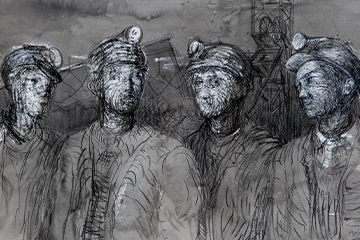Andy Holden, Paul Johnson, Harold Offeh, Katie Paterson, Feral Practice and Celia Pym
UH Arts + Culture are delighted to present Empathy for People, Empathy for Things – a group exhibition exploring an important issue of our time – empathy – and what that might mean for how we relate with each other and connect to the things around us.
The exhibition looks at our relationships with human and non-human things. It includes artists who create moments to listen, reflect and connect to human and non-human stories.
It is thought that the English word ‘Empathy’ comes from the German word ‘Einfunlung’ meaning to feel into or ‘resonate’ with works of art which later was used to describe resonance between human beings. How do we resonate with others and other things? Does this resonating empathy help us to shift towards a more equal, less anthropocentric view of the world?
The exhibition includes artists who are crafting practices and artworks that explore empathy from a number of perspectives. Celia Pym trained in textiles and as a nurse, she repairs clothing and things – an act that values the materials, the object, and the people to which they are connected. This sense of connection between objects and people is also reflected in Andy Holden’s Pyramid Piece (2010) – over time his emotional and intellectual relationship with a piece of rock he took as a child led him to return it to its place of origin, The Pyramids, a place with great meaning to many people. Paul Johnson’s Wallet (2005-2010) looks at a relationship between time, object, and human in a more un-demanding and open way. Through simply existing together in the artist’s pocket, the wallet was transformed into something else.
Harold Offeh’s film Body Landscape Memory. Symphonic Variations on an African Air, Op.63 (2019) focusses on the presentation of Black bodies in the landscape. Moving away from stereotypes of the victimised body, the work explores leisure and connections to the physical environment. Feral Practice invite us to think about the landscape beneath our feet and use the ancient craft of meditation to tap into the vast, important, and often invisible mycorrhizal fungi. Katie Paterson’s Future Library (2014 – 2114) stretches beyond the expected timeline of producing a book and invites us to consider the life span of trees, and future peoples and what they may read.
Our relationships with each other and other non-human things are increasingly pertinent. From listening and making space for each other’s histories, to studying trees and understanding the lives of fungi; there is a cultural shift emerging in the West. Thinking less about dominating and controlling nature, and more about working respectfully with each other and our worlds.
Events:
Private View: Tuesday 25 October, 17:00-18:30
Please email uharts@herts.ac.uk if you would like to join us.
Create with Celia Pym in the Gallery:
Tuesday 8, Wednesday 9 and Thursday 10 November, 11:00-15:00
More events to be announced soon. Please sign up to our mailing list below to be the first to know about associated events and how to book
Thumbnail image credit: Harold Offeh, still from ‘Body Landscape Memory. Symphonic Variations on an African Air, Op.63', 2019


